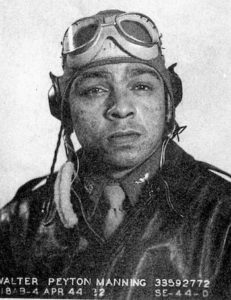
Walter P. Manning
*Walter P. Manning was born on this date in 1920. He was a Black military officer and pilot.
Walter Peyton Manning was born in Baltimore, Maryland, and grew up in Philadelphia, PA. When World War II started, Manning wanted to serve, but in 1942, he was rejected for military service because of a hammertoe. Manning used his savings to pay for surgery to repair his toe so he could enlist. In 1943 he enlisted in the Army Air Force. In 1944, after graduation, he was assigned to the 301st Fighter Squadron, 332nd Fighter Group, with the rank of 2nd lieutenant. He served as a pilot from Ramitelli Air Base, Italy.
Manning was a member of the Tuskegee Airmen. Manning was involved in a dogfight with Nazi planes on Easter morning, April 1, 1945, over the Danube River. Tuskegee Airmen escorted B-24 bombers on a bombing mission to St. Polten, Austria. On the return trip to their base, the group spotted enemy planes near Wels, Austria. Seven Tuskegee Airmen were flying the mission that day, and they engaged the German planes. The Tuskegee Airmen shot down 12 German planes in the dogfight. However, three of the Tuskegee Airmen's planes were shot down: one pilot was able to make crash-land in friendly territory, one was killed outright when he was shot down, and the third pilot was Manning: his plane was damaged so badly that he had to bail out. He parachuted into a waiting mob.
On April 3, 1945, Manning was captured and jailed in Austria at a Nazi Luftwaffe Air Force base near Linz. A gang of citizens helped by Luftwaffe officers broke into the jailhouse and tied Manning's hands behind his back. They dragged Manning outside and beat him badly. They hung a wooden tablet around his neck that read "We help ourselves! The Werewolf" and hanged him from a lamppost. He flew 50 missions and was awarded the Air Medal for heroism six times.
After the end of the war, his body was recovered by US troops. Although they found clear signs of murder, US officials closed his case early. Nobody was ever sentenced for war crimes. Research and commemoration In 2013, the Austrian historians Nicole-Melanie Goll and Georg Hoffmann carried out a research project with Jerry Whiting to clarify the fate of Walter Manning. As a result of their findings, the Austrian Army raised a commemoration plaque at the place where Walter Manning was murdered.